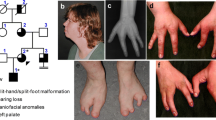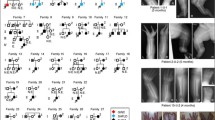Abstract
Split-hand/foot malformation (SHFM) associated with aplasia of long bones, SHFLD syndrome or Tibial hemimelia-ectrodactyly syndrome is a rare condition with autosomal dominant inheritance, reduced penetrance and an incidence estimated to be about 1 in 1,000,000 liveborns. To date, three chromosomal regions have been reported as strong candidates for harboring SHFLD syndrome genes: 1q42.2–q43, 6q14.1 and 2q14.2. We characterized the phenotype of nine affected individuals from a large family with the aim of mapping the causative gene. Among the nine affected patients, four had only SHFM of the hands and no tibial defects, three had both defects and two had only unilateral tibial hemimelia. In keeping with previous publications of this and other families, there was clear evidence of both variable expression and incomplete penetrance, the latter bearing hallmarks of anticipation. Segregation analysis and multipoint Lod scores calculations (maximum Lod score of 5.03 using the LINKMAP software) using all potentially informative family members, both affected and unaffected, identified the chromosomal region 17p13.1–17p13.3 as the best and only candidate for harboring a novel mutated gene responsible for the syndrome in this family. The candidate gene CRK located within this region was sequenced but no pathogenic mutation was detected.




Similar content being viewed by others
References
Abecasis GR, Cherny SS, Cookson WO, Cardon LR (2002) Merlin-rapid analysis of dense genetic maps using sparse gene flow trees. Nat Genet 30:97–101
Babbs C, Heller R, Everman DB, Crocker M, Twigg SR, Schwartz CE, Giele H, Wilkie AO (2007) A new locus for split hand/foot malformation with long bone deficiency (SHFLD) at 2q14.2 identified from a chromosome translocation. Hum Genet 2007 122:191–199
Cottingham RW Jr, Idury RM, Schaffer AA (1993) Faster sequential genetic linkage computations. Am J Hum Genet 53:252–263
De Mollerat XJ, Gurrieri F, Morgan CT, Sangiorgi E, Everman DB, Gaspari P, Amiel J, Bamshad MJ, Lyle R, Blouin JL, Allanson JE, Le Marec B, Wilson M, Braverman NE, Radhakrishna U, Delozier-Blanchet C, Abbott A, Elghouzzi V, Antonarakis S, Stevenson RE, Munnich A, Neri G, Schwartz CE (2003) A genomic rearrangement resulting in a tandem duplication is associated with split hand–split foot malformation 3 (SHFM3) at 10q24. Hum Mol Genet 12:1959–1971
Fernandez-Palazzi F, Bendahan J, Rivas S (1998) Congenital deficiency of the tibia: a report on 22 cases (review). J Pediatr Orthop B 7:298–302
Ianakiev P, Kilpatrick MW, Toudjarska I, Basel D, Beighton P, Tsipouras P (2000) Split-hand/split-foot malformation is caused by mutations in the p63 gene on 3q27. Am J Hum Genet 67:59–66
Kano H, Kurosawa K, Horii E, Ikegawa S, Yoshikawa H, Kurahashi H, Toda T (2005) Genomic rearrangement at 10q24 in non-syndromic split-hand/split-foot malformation. Hum Genet 118:477–483
Maestrelli SRP, Otto PA (1997) Estimation of penetrance and calculation of recurrence risks in autosomal dominant diseases with incomplete penetrance (Estimativa da Penetrância e Cálculo de Riscos de Recorrência em Doenças Condicionadas por Mecanismo Hereditário Autossômico Dominante com Penetrância Incompleta). Braz J Dysmorphol Speech Hear Disord 1:55–66
Majewski F, Uster W, ter Haar B, Goecke T (1985) Aplasia of tibia with split-hand/split-foot deformity: report of six families with 35 cases and considerations about variability and penetrance. Hum Genet 70:136–147
Majewski F, Goecke T, Meinecke P (1996) Ectrodactyly and absence (hypoplasia) of the tibia: are there dominant and recessive types? Am J Med Genet 63:185–189
Malik S, Arshad M, Amin-Ud-Din M, Oeffner F, Dempfle A, Haque S, Koch MC, Ahmad W, Grzeschik KH (2004) A novel type of autosomal recessive syndactyly: clinical and molecular studies in a family of Pakistani origin. Am J Med Genet A 126:61–67
Malik S, Percin FE, Ahmad W, Percin S, Akarsu NA, Koch MC, Grzeschik KH (2005) Autosomal recessive mesoaxial synostotic syndactyly with phalangeal reduction maps to chromosome 17p13.3. Am J Med Genet A 134:404–408
Managoli SS, Chaturvedi P (2005) Tibial hemimelia-split hand/foot syndrome with rare anomalies. Indian Pediatr 42:190–191
Naveed M, Al-Ali MT, Murthy SK, Al-Hajali S, Al-Khaja N, Deutsch S, Bottani A, Antonarakis SE, Nath SK, Radhakrishna U (2006) Ectrodactyly with aplasia of long bones (OMIM; 119100) in a large inbred Arab family with an apparent autosomal dominant inheritance and reduced penetrance: clinical and genetic analysis. Am J Med Genet A. 140:1440–1446
Naveed M, Nath SK, Gaines M, Al-Ali MT, Al-Khaja N, Hutchings D, Golla J, Deutsch S, Bottani A, Antonarakis SE, Ratnamala U, Radhakrishna U (2007) Genomewide linkage scan for split-hand/foot malformation with long-bone deficiency in a large Arab family identifies two novel susceptibility loci on chromosomes 1q42.2–q43 and 6q14.1. Am J Hum Genet 80:105–111
Online Mendelian Inheritance in Man (OMIM), http://www.ncbi.nih.gov/OMIM/
Richieri-Costa A, Ferrareto I, Masiero D, Ald da Silva CRM (1987a) Tibial hemimelia report on 37 new cases, clinical and genetics considerations. Am J Med Genet 27(4):867–884
Richieri-Costa A, Brunoni D, Laredo-Filho J, Kasinski S (1987b) Tibial aplasia-ectrodactyly as variant expression of the Gollop–Wolfgang complex: report of a Brazilian family. Am J Med Genet 28:971–980
Richieri-Costa A, de Miranda E (1988) Short stature, abnormal ears, monodactylous tetraectrodactyly, cleft palate in a Brazilian boy. Am J Med Genet 31:559–564
Rogatko A, Pereira CAB, e Frota-Pessoa O (1986) A Bayesian method for estimation of penetrance: application to mandibulofacial and frontonasal dysostoses. Am J Hum Genet 24:231–246
Rozen S, Skaletsky H (2000) Primer3 on the WWW for general users and for biologist programmers. In: Krawetz S, Misener S (eds) Bioinformatics methods and protocols: methods in molecular biology. Humana Press, Totowa, pp 365–386
Sener RN, Isikan E, Diren HB, Sayli BS, Sener F (1989) Bilateral split hand with bilateral tibial aplasia. Pediatr Radiol 19:258–260
Van Bokhoven H, Hamel BC, Bamshad M, Sangiorgi E, Gurrieri F, Duijf PH, Vanmolkot KR, van Beusekom E, van Beersum SE, Celli J, Merkx GF, Tenconi R, Fryns JP, Verloes A, Newbury-Ecob RA, Raas-Rotschild A, Majewski F, Beemer FA, Janecke A, Chitayat D, Crisponi G, Kayserili H, Yates JR, Neri G, Brunner HG (2001) p63 Gene mutations in EEC syndrome, limb-mammary syndrome, and isolated split hand–split foot malformation suggest a genotype-phenotype correlation. Am J Hum Genet 69:481–492
Winter RM, Baraitser M (1987) The London dysmorphology database. J Med Genet 24:509–510
Zlotogora J (1994) On the inheritance of the split hand/split foot malformation (review). Am J Med Genet 53:29–32
Acknowledgments
The authors thank all family members for their enrollment in this study and laboratory fellows for their collaboration, especially Renata Soares Thiele de Aguiar for her invaluable help and Camila Juncansen, Katia Maria da Rocha, Maria Teresa Balester de Mello Auricchio and Martha Lima-Cozzo for technical support. We also thank Dr. Nina Amália Brancia Pagnan for her collaboration in the clinical evaluation of some patients; Dr. Diogo Meyer, Rodrigo Ramalho, Andrea R. Horimoto and Natale Cavaçana for helping with the Lod score calculations. This work was financially supported by FAPESP and PRONEX—Conselho Nacional de Desenvolvimento Científico e Tecnológico (CNPq).
Author information
Authors and Affiliations
Corresponding author
Additional information
Contract grant sponsors: CEPID—Fundação de Amparo à Pesquisa do Estado de São Paulo (FAPESP) and PRONEX—Conselho Nacional de Desenvolvimento Científico e Tecnológico (CNPq).
Rights and permissions
About this article
Cite this article
Lezirovitz, K., Maestrelli, S.R.P., Cotrim, N.H. et al. A novel locus for split-hand/foot malformation associated with tibial hemimelia (SHFLD syndrome) maps to chromosome region 17p13.1–17p13.3. Hum Genet 123, 625–631 (2008). https://doi.org/10.1007/s00439-008-0515-7
Received:
Accepted:
Published:
Issue Date:
DOI: https://doi.org/10.1007/s00439-008-0515-7




